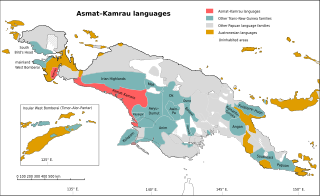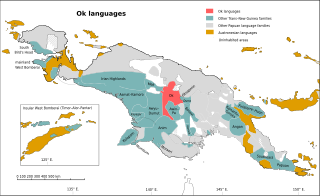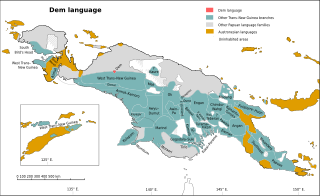
Netherlands New Guinea refers to the Papua region of Indonesia while it was a part of the Dutch East Indies until 1949, later an overseas territory of the Kingdom of the Netherlands from 1949 to 1962. It was commonly known as Dutch New Guinea. It contained what are now Indonesia's two easternmost provinces, Papua and West Papua, which were administered as a single province prior to 2003 under the name Irian Jaya.
The Sko or Skou languages are a small language family spoken by about 7000 people, mainly along the Vanimo coast of Sandaun Province in Papua New Guinea, with a few being inland from this area and at least one just across the border in the Indonesian province of Papua.

Puncak Trikora, until 1963 Wilhelmina Peak, is a 4,730 or 4,750-metre-high (15,584 ft) mountain in the Papua province of Indonesia on New Guinea. It lies in the eastern part of the Sudirman (Nassau) Range of the Maoke Mountains.
The Lakes Plain languages are a family of Papuan languages, spoken in the Lakes Plain of Indonesian New Guinea. They are notable for being heavily tonal and for their lack of nasal consonants.
Aghu, or Central Awyu, is a Papuan language of Papua, Indonesia. It may actually be two languages, depending on one's criteria for a 'language'. The two varieties are: Mappi River Awyu (Aghu) and Pasue River Awyu.

Ekari is a Trans–New Guinea language spoken by about 100,000 people in the Paniai lakes region of the Indonesian province of Papua, including the villages of Enaratoli, Mapia and Moanemani. This makes it the second-most populous Papuan language in Indonesian New Guinea after Western Dani. Language use is vigorous. Documentation is quite limited.

The Asmat – Kamrau Bay languages are a family of a dozen Trans–New Guinea languages spoken by the Asmat and related peoples in southern Western New Guinea. They are believed to be a recent expansion along the south coast, as they are all closely related, and there is little differentiation in their pronouns.
The Pauwasi languages are a likely family of Papuan languages, mostly in Indonesia. The subfamilies are at best only distantly related. The best described Pauwasi language is Karkar, across the border in Papua New Guinea. They are spoken around the headwaters of the Pauwasi River in the Indonesian-PNG border region.

The Kaure–Kosare or Nawa River languages are a small family spoken along the Nawa River in West Papua, near the northern border with Papua New Guinea. The languages are Kaure and Kosare.
The Dani or Balim Valley languages are a family of clearly related Trans–New Guinea languages spoken by the Dani and related peoples in the Balim Valley in the highlands of Papua Province, Indonesia. Foley (2003) considers their TNG status to be established. They may be most closely related to the languages of Paniai Lakes, but this is not yet clear. Capell (1962) had posited that their closest relatives were the Kwerba languages, which Ross (2005) rejects.
The Paniai Lakes languages, also known as the Wissel Lakes or Wissel Lakes – Kemandoga River, are a small family of closely related Trans–New Guinea languages spoken in the Paniai Lakes region of the highlands of Western New Guinea in the Paniai Lakes region of Papua. Foley (2003) considers their Trans–New Guinea status to be established.

The Ok languages are a family of about a dozen related Trans–New Guinea languages spoken in a contiguous area of eastern Irian Jaya and western Papua New Guinea. The most numerous language is Ngalum, with some 20,000 speakers; the best known is probably Telefol.
The Demta–Sentani languages form a language family of coastal Indonesian Papua near the Papua New Guinea border.

Puncak Jaya or Carstensz Pyramid, Mount Jayawijaya or Mount Carstensz is the highest mountain in Indonesia, on the island of New Guinea, with an elevation of 4,884 m (16,024 ft). It is the highest peak of an island on Earth, and the highest peak in Oceania. Located in the Sudirman Range of the western central highlands of Papua Province, Indonesia, in the southwest of Puncak Jaya Regency. The massive, open cut Grasberg gold and copper mine, the world's largest gold mine, is 4 km (2.5 mi) west of Puncak Jaya.

Dem is a divergent Papuan language of West New Guinea. Although Palmer (2018) leaves it unclassified, it was tentatively included in the Trans–New Guinea family in the classification of Malcolm Ross (2005), and Timothy Usher ties it most closely to Amung.

Kaure is a Papuan language of West Papua. It is spoken in the villages of Lereh, Harna, Wes, Masta, and Aurina.
Kayagar is a Papuan language of Papua, Indonesia.
Marind is a Papuan language spoken in Malind District, Merauke Regency, Indonesia by over ten thousand people. Dialects are Southeast Marind, Gawir, Holifoersch, and Tugeri. Bian Marind, a.k.a. Boven-Mbian, is divergent enough to not be mutually intelligible, and has been assigned a separate ISO code.
The Wolani or Wodani are a people in the Indonesian Paniai regency (kabupaten) of the Papua province of West Papua. Numbering about 5000 in 1992, they are farmers who live in the central highlands northeast of Lake Paniai, along the Kemandoga and Mbiyandogo rivers. Many Wolani converted to Christianity but, like elsewhere in Indonesia, they retain their traditional religion. They speak Wolani, which is affiliated with the western branch of the Trans–New Guinea languages, similar to the nearby Ekari and Moni languages.

Johannes Cornelis Anceaux was a Dutch linguist and anthropologist known for his extensive work on Papuan and Austronesian languages.









